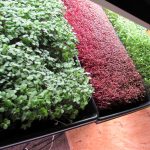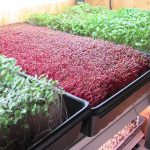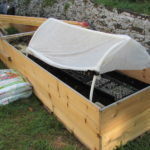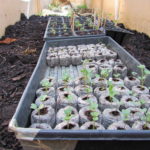I’ve just had a huge “a-ha!” moment! I think I can officially say that I now know how to start brassica seeds! Sounds silly doesn’t it? But, for the first time ever, there are some really gorgeous cabbage, broccoli, cauliflower and brussels sprouts seedlings just waiting to be transplanted into the fall garden. And it was such a simple fix from my previous method that always ended in disaster.
Let me back up just a bit. I have always had great luck with starting tomatoes, peppers, eggplants, squash, zucchini, canteloupe and cucumbers. No problem. But, anything from the brassica family? Nope. Nada.
I’ve always started all my seeds under the shop light fixtures I use for the different varieties of microgreens I grow for farmer’s markets and – except for the brassicas – I’ve had really good luck.
The florescent shop lights each have a warm and a cool tube which supposedly supplies the full spectrum of light. All of my starts have always done well — except for those pesky brassicas. But, as it turns out, the 1,600 lumens the shop lights produce is not strong enough for the brassica family. So, a couple of weeks ago, I put a hoop tunnel over one section of our newly constructed sixteen foot raised bed. I covered it with a double layer of row cover held in place by clamps. This particular bed gets a full eight hours of bright, hot sun each day and I was sure that, even with the row cover, it would be much too intense for sensitive broccoli and cabbage starts. But it’s working! The brussels sprouts seedlings are about three inches tall with nice fat, healthy stems. Ditto for the cabbage, cauliflower, broccoli and dinosaur kale. I even started some spinach under there since there’s no room among all the summer veggies in the garden to just cast seed.
After doing a bit of research (amazing how helpful that can be, right?) it became apparent to me that, while brassicas are not fond of hot weather and can’t take direct, full sun, they do need a lot of light to sprout and grow into strong seedlings. The florescent lights that were perfect for growing healthy microgreens did not have a high enough lumen count for brassica seedlings. Each spring and each fall I inevitably headed to a home improvement store or a farmer’s market for brassica plants to transplant into the garden. Sigh. But now, with luck, we’ll be completely self sufficient in this area and start all our own healthy seedlings. Anyway, the fingers are crossed that there will be strong brassicas going in the garden in a few more weeks. More photos coming when we get some sunshine, but here’s what the whole seed starting thing looked like a week and a half ago: (And yes, I do know — peat is a nonrenewable resource — but I’m using up several boxes I had stockpiled before I found that out).
And while I’m thinking about the whole seed starting process, research led me a couple of years ago to a tip about preventing damping off (another problem I was having with seed starting). Apparently, in addition to fungal issues in the soil itself, those little gnats that love to prowl around your seedlings also help spread a fungus that can kill seedlings. But, by sprinkling a tiny bit of cinnamon on the top of the potting soil, you can eliminate that problem. It cured the problem and I never had any more fungus gnats on my seedlings. Plus, it only takes a tiny bit of cinnamon.
It’s just really cool to learn all these techniques and put them to use. Learning is fun when it results in tasty vegetables you can cram into your mouth! Yum!





2 Comments
Been reading your stuff. Always good to hear from you. Keep in touch
Thanks Lew! We always had some great “garden” talks! It’s great to be living it.